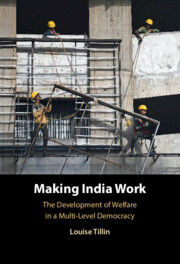Book contents
- Making India Work
- Making India Work
- Copyright page
- Dedication
- Contents
- Illustrations
- Acknowledgments
- Abbreviations
- 1 Introduction
- 2 Origins, Expansion, and Reform
- Part I Building a National Economy: Regulating Internal Competition
- Part II Putting India to Work
- Part III Liberalisation and Welfare in a Multi-level Democracy
- 7 Liberalisation and the ‘Social Safety Net’
- 8 Welfare, Rights, and the Market in the Post-Congress Polity, 1998–2014
- 9 Conclusion
- Bibliography
- Index
9 - Conclusion
The Past and Future of the Welfare State in India
from Part III - Liberalisation and Welfare in a Multi-level Democracy
Published online by Cambridge University Press: 13 February 2025
- Making India Work
- Making India Work
- Copyright page
- Dedication
- Contents
- Illustrations
- Acknowledgments
- Abbreviations
- 1 Introduction
- 2 Origins, Expansion, and Reform
- Part I Building a National Economy: Regulating Internal Competition
- Part II Putting India to Work
- Part III Liberalisation and Welfare in a Multi-level Democracy
- 7 Liberalisation and the ‘Social Safety Net’
- 8 Welfare, Rights, and the Market in the Post-Congress Polity, 1998–2014
- 9 Conclusion
- Bibliography
- Index
Summary
This chapter offers an overview of the arguments and key contributions of the book. The book has shown that while clientelism and resource constraints have rationed the provision of public goods and social benefits, across the past century, Indians have engaged in deliberate debates about what an Indian ‘welfare state’ should look like. The ideas and principles on which earlier policies were conceived have remained influential. India’s welfare regime today is shaped by decisions taken and resources allocated in the past. Even moments of expected rupture such as the onset of economic reforms in 1991 - or, as this chapter goes on to show, the 2014 Lok Sabha elections which brought the Narendra Modi-led BJP to power on a platform promising an end to a culture of ‘entitlements’ - have seen underlying stability in the context of India’s welfare regime. This said, there have been substantial areas of divergence over time in both the approach to social policy implementation and the philosophy of citizenship that underpins welfare commitments. The chapter ends by looking ahead to the future of welfare, underlining the continued significance of state-level policy innovation.
Keywords
- Type
- Chapter
- Information
- Making India Work , pp. 193 - 211Publisher: Cambridge University PressPrint publication year: 2025

